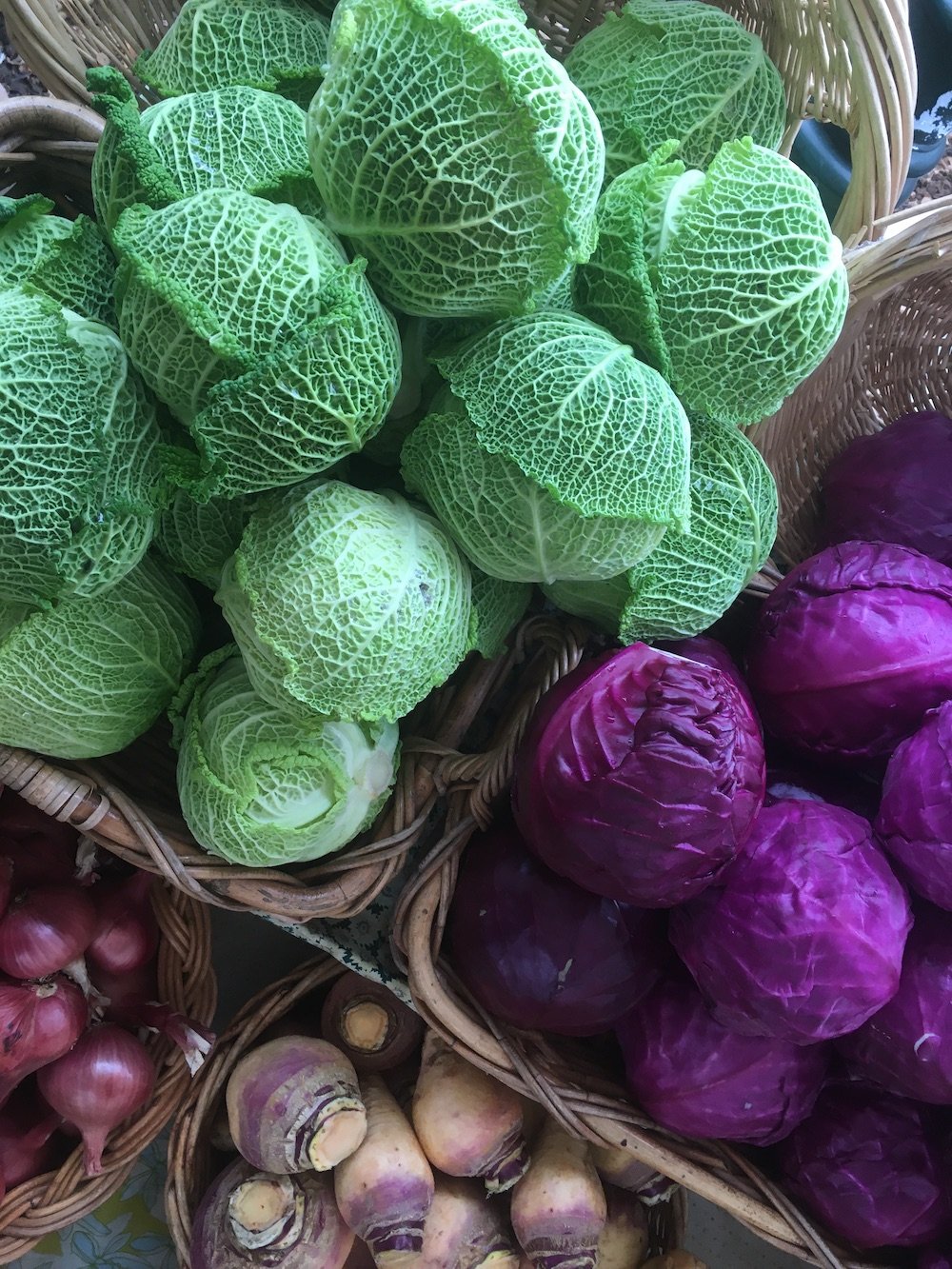Brassica Buds
From cabbages to Brussels sprouts to Kalettes, all of these veggies are botanically just modified buds. Cabbages are an enlarged terminal bud whereas Brussels sprouts and Kalettes are both lateral buds. From staple crops to hot new items at the farmers market, Brassica buds make a big impact in our communities and on our plates.
Whether cabbage is fermented into a sauerkraut or kimchi, sliced thin and enjoyed raw in a slaw or salad, softened in a soup, or roasted like steaks until golden brown, cabbage is versatile, cheap, and extremely delicious.
Cabbage
Cabbage. There’s just something serious about this vegetable, it’s not messing around. Like potatoes or corn, this crop has meant life or famine to cultures around the world, and for good reason. During cold winter months, anything crisp and fresh and green becomes a hot commodity. And unlike lettuces and even some mustards and kales, cabbages can withstand freezing cold winters and get sweeter with each day that passes. Just peel off the outer leaves to reveal the crisp center within, or ferment with salt and store for months that way.
Green and purple cabbages are pretty common, ubiquitous in grocery stores and in slaws at backyard barbecues. Savoy cabbage (pictured) is a much lighter cabbage. Due to its hyper-rumply or “savoyed” leaf shape, savoy cabbage is about half as dense as plain green cabbage. These rumples are perfect for capturing the cooking juices or dressings that they end up in on our plate, making for a flavorful as well as textural delight.
And then there’s conehead cabbage, the rather large head of cabbage that is shaped quite like a cone, as the name implies. Within the stiffer cabbages mentioned above, there is still more diversity that can be explored in local seed catalogues.
Napa Cabbage
Elongated in shape rather than round, and with much looser juicier leaves similar to a savoy cabbage, Napa cabbage has much more delicate greens compared to other cabbages. Much higher in water content, Napa cabbage makes super tasty juicy slaws and is best used fresh rather than stored for long periods of time. Traditionally, Napa cabbage has been salted to release its water content before being fermented into kimchi and being stored for months that way. There’s nothing like a crisp spicy leaf of kimchi'd Napa cabbage to cut through a plate of starches and heavy winter foods.
Brussels Sprouts
Brussels sprouts, another one of those vegetables that people love to hate, is truly such a special seasonal treat. Not only are they extremely buttery delicious when roasted with a little oil, garlic, and salt, but they are quite the labor intensive crop to grow. Each little mini cabbage has to be picked and peeled and cleaned by hand. It takes a lot of time and energy to bring Brussels sprouts from farm to table.
Pictured here is the first Brussels sprout harvest of the season in fall of 2020. My crew, including Eva and Merced pictured here, set to the task of picking some Brussels in bulk and some to sell by the stalk at market.
Growing Brussels sprouts organically is actually a very difficult task. Because they’re out in the field for so long and because they create a dense forest full of nice tight little cozy leaves for pests to nestle into, it’s very difficult to grow pristine Brussels, which is why it takes so darn long to harvest & clean them. After spending many winters kneeling in the mud using frozen fingers to peel at each tiny sprout until it’s clean, I have a deep respect for Brussels sprouts and feel grateful anytime they make it to my plate! Also, although not pictured here, Brussels sprouts come in both green and purple.
Brussels sprout harvest and a walk through a bursting beautiful Brassica patch in Philomath, Oregon. Patch walks us through Kalettes, Brussels sprouts, Lacinato black kale, green curly kale.
Kalettes
Last but not least, Kalettes are the hottest new vegetables to grace the tables of farmers markets in Portland, Oregon. A cross between Brussels sprouts and red kale, Kalettes grow just like Brussels sprouts do, only instead of the lateral buds forming closed little mini cabbages along the stalk, they form open little rosettes of kale.
I am obsessed with Kalettes as both an eater and a farmer. As an eater, oh my goodness are these things tasty! Simply toss them in some oil and salt in either a frying pan or on a sheet pan in the oven, and you’ve got savory buttery little centers with crispy kale-chip leaves on the outside, no chopping needed. So good so good so good. Serve them alongside a creamy pasta, or season them with a little soy sauce / Tamari and serve with rice, or enjoy alongside fried eggs or in a breakfast frittata. Sometimes I just stand in the kitchen and eat them straight off the roasting pan. Roast until super crispy and they are amazing dipped in a little garlic herb mayo / aioli.
And on the farming side, the open leaves don’t attract aphids as badly, and they are much, much easier to clean than Brussels taking well under half the time to process. All in all, kalettes are really cool.

































